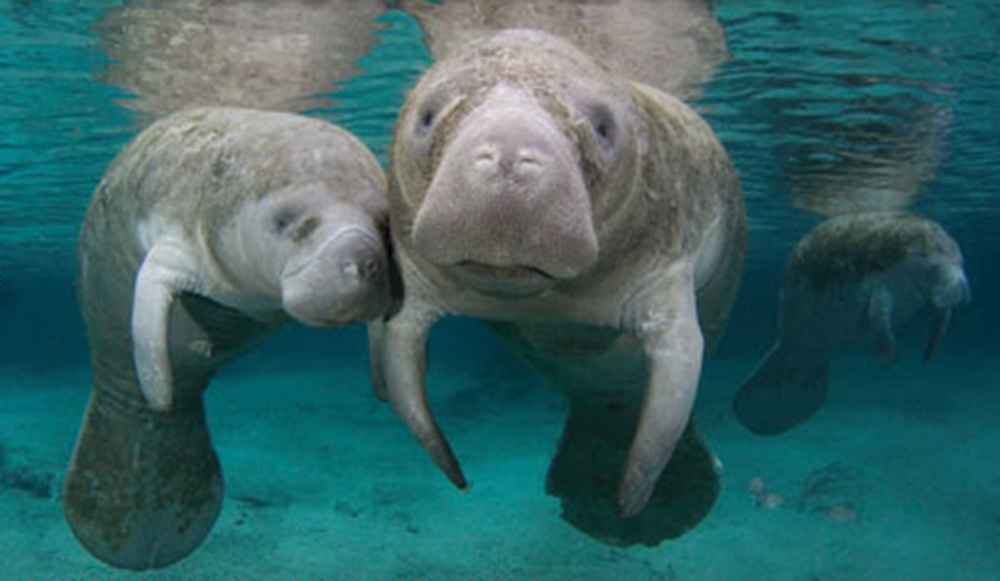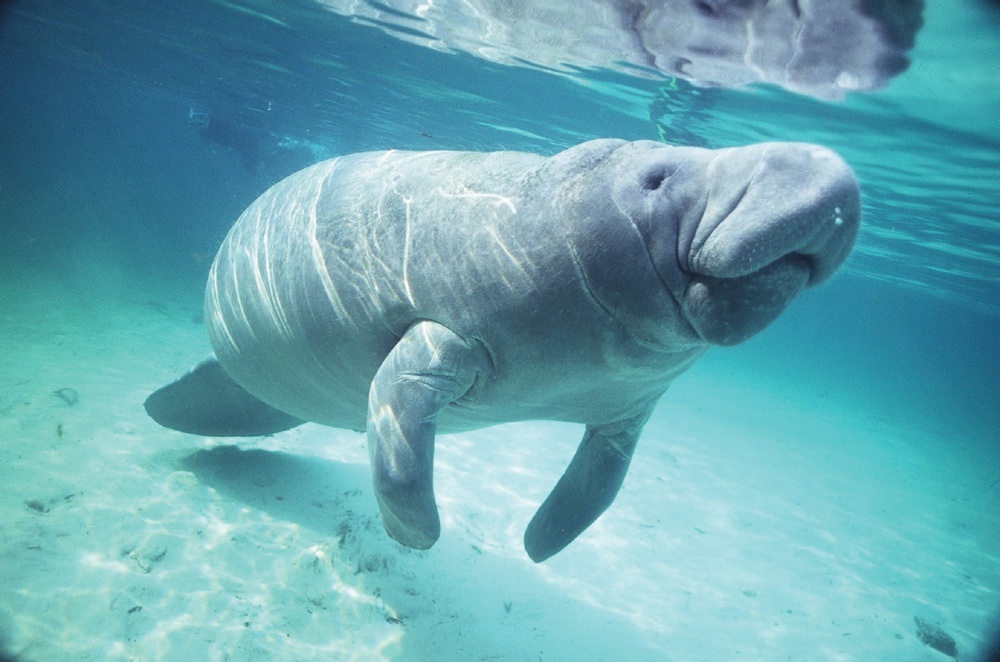NO LONGER ENDANGERED, MANATESS NOW FACE ANOTHER CRISIS
– NEWS@TheU
A massive seagrass die-off in the Indian River Lagoon, coupled with continued threats from boating strikes, is putting these gentle sea cows in peril once again.
Some never make it, perishing from deadly boat strikes in Florida waters before animal care specialists can reach them.
Others are brought to zoos and aquariums with punctured lungs, lacerations, and fins so badly damaged from net entanglements that they must be amputated.
For University of Miami researcher Jill Richardson, who has helped care for several sick and injured manatees at rehabilitation facilities in Florida, it is always a “deeply emotional” experience to see these gentle sea cows suffer from such wounds.
“The absolute goal is to help them heal, regain their health, and return them to the wild. But not all of them survive,” said Richardson, senior lecturer in the Department of Marine Biology and Ecology at the Rosenstiel School of Marine and Atmospheric Science. “It’s a stark warning and harsh reality about the impacts we, as humans, are having on these iconic and sensitive mammals.”
In 2021, a staggering 1,101 manatees died in Florida, making last year the deadliest on record in the state for these slow-moving, herbivorous creatures, according to the Florida Fish and Wildlife Conservation Commission.
But not all the deaths can be attributed to boat collisions. Many of the manatees starved to death after pollutants in the 156-mile-long Indian River Lagoon, where the creatures gather in the winter, killed large swathes of their primary food source —seagrass.

Indeed, the recent declines in seagrass abundance and health in the lagoon and other estuaries where manatees feed are directly related to poor water quality, said seagrass expert Diego Lirman, an associate professor of marine biology and ecology at the Rosenstiel School. “The specific triggers vary spatially and temporally, but the underlying causes are related to declines in water quality,” he said.
Lirman specifically noted increases in nutrients coming from urban, agricultural, and industrial land sources, the alteration of freshwater deliveries from the Everglades that cause sudden drops in salinity and bring in an abundance of nutrient-rich water through rivers and canals that dump large amounts of fresh water over a short period of time and over a reduced coastal footprint into semi-enclosed coastal bays like Biscayne Bay and Florida Bay.
“Declines in light availability caused by sedimentation related to dredging and construction, excess nutrients, and micro- and macroalgal blooms make it hard for seagrass to photosynthesize, and they eventually die,” Lirman said. “And seagrass decomposition increases organic and inorganic matter in the water column and sediments, causing additional seagrass mortality.”
He said temperature extremes driven by climate change exacerbate the impacts of these drivers.
The water quality problem, however, cannot be resolved overnight, Richardson said. “Though replanting efforts may be a viable, short-term solution, it’s a like putting a small Band-Aid on a large, gaping wound,” she said. “Until we make significant changes to improve water quality along Florida’s coastlines, these efforts will remain futile in the long run.”
If anything, the problem will only worsen as coastal development in Florida continues at a rapid clip, Richardson reported.
“With development comes additional nutrient pollution and habitat degradation,” she pointed out. “And as Florida’s population continues to grow beyond 21 million people, with a simultaneous increase in the number of registered recreational watercraft, the potential for boat related deaths also increases.”
Laws that protect manatees have been on the books for decades. They are federally protected under the Marine Mammal Protection Act of 1972 and the Endangered Species Act of 1973. Meanwhile, the Florida Manatee Sanctuary Act of 1978 establishes restrictions to protect the mammals from boat collisions and from harassment; to safeguard their habitats from destruction by boats or other human activity; and to provide safe havens where they can rest, feed, reproduce, give birth, or nurse undisturbed by humans.
Such restrictions as well as other conservation measures such as extensive rescue and rehabilitation efforts have helped the manatee rebound from only a few hundred in the 1970s to more than 6,000 in the Southeastern U.S. today. As such, the animals were removed from the endangered species list in 2017 and moved down to the threatened species list.
“However, without a healthy ecosystem, it’s unlikely manatees will continue to thrive,” Richardson said.

Manatees living on Florida’s east coast, she noted, have limited genetic diversity, which puts them at greater risk of significant loss during episodes of rapid change in their environments such as unusually cold winters, the widespread loss of seagrasses, and algal bloom outbreaks. “Regardless of genetics, large, anomalous increases in manatee mortalities, such as what we are seeing right now in Florida, are a significant cause for concern regarding long-term species survival,” Richardson said. Manatees, she indicated, are a critical link in the ecosystem, consuming predominantly new seagrass growth and, thereby, promoting a high level of primary productivity in communities of that species. “In this sense, they have been deemed ‘cultivation grazers,’ clearing space for faster growing, more nutritious seagrass species to thrive,” Richardson explained.
But the widespread loss of seagrass communities has put manatees in peril, leaving them with fewer options for sustenance. “There are very serious concerns regarding the nutritional status of manatees and whether or not a continuously degrading environment can support them now and into the future,” Richardson said. “And this is exacerbated during the winter months when manatees struggle to stay warm. Despite their size, they have very little blubber and experience a condition called cold stress syndrome when exposed to water temperatures below 68 degrees for extended periods of time,” she added. “Without ample food resources, coupled by limited access to warm water, they cannot achieve the energetic demands of thermoregulation and often perish.’’
According to the researcher, we then “add exposure to red tide events and other algal blooms to what are likely already immune compromised and nutritionally deficient manatees, and it’s a disheartening ‘perfect storm’ of potential widespread losses.”
In a move to save manatees from starvation, Florida wildlife officials recently started feeding romaine lettuce to manatees gathered at warm-water sites. But such a practice, warned Richardson, comes with concerns.
“Of course, exceptions can be made under the experienced and watchful oversight of trained managers and scientists, but it’s very important for the public to understand that feeding manatees is detrimental to their health, as it brings them into closer contact with humans and exposes them to greater associated risks,” she emphasized. “But I have no doubt that FWC (Florida Fish and Wildlife Conservation Commission) and partner organizations have a very detailed plan in place to minimize this association and ensure long-term manatee health and survival. In the bigger picture, this decision is very telling and a strong indication that the coastal ecosystem is no longer able to support manatees, particularly during difficult winter months.



